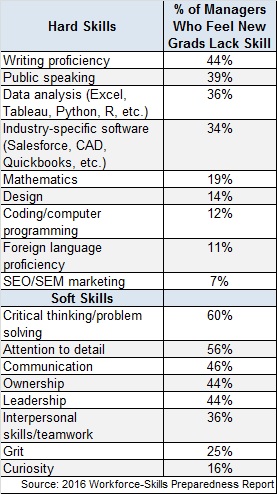The Terminator had a big impact on my understanding of the future. In the Terminator franchise, machines become so artificially intelligent that Skynet ultimately takes over and attacks humans in a judgment day. While judgment day has been pushed out further during the course of the series, the sense is that it still looms just over the horizon.
PayScale’s 2017 Compensation Best Practices Report uncovered some bleak visions of the future. We asked organizations to reveal their biggest fears for the future and the fate of their talent. Some mentioned the realities of millennial job hopping combined with boomer retirement; others were concerned about attrition of newly trained employees; still others spoke more broadly about their ability to find and grow great talent. One respondent talked about the fierce talent competition that is shifting the balance of power to candidates.
The concern about both retaining and finding top talent in an uncertain time remains top of mind for most HR professionals today. The shifting workforce, changing U.S. and global political landscape, and technology trends all point to a future workforce with different motivators than today. How are these future trends impacting employees? Who is the workforce of tomorrow? And how can employers build compensation that will reinforce tomorrow’s workforce starting right now?
Three future trends happening now
My generation has already seen the end of pensions. Social Security is in question and health benefits are more uncertain than ever. As the workforce becomes more and more mobile, tomorrow’s workforce isn’t modeled around long tenures either. Here are trends that are impacting the way employers attract, retain and motivate employees.
- Gig economy — With the rise of companies like Uber and Lyft, more and more workers are using technology to support side incomes, or even develop their main revenue stream without ever becoming an employee of a company.
- Slashies — While wearing multiple hats has been common in smaller organizations, automation of tasks is making slashies more prevalent in larger organizations as well. Think Sales/Account Management, Front Desk Attendant/Admin, or Office Manager/HR/Payroll.
- Automation — As self-driving cars become a reality, ships get unloaded by robots, and machines continue to replace humans in manufacturing, automation is becoming a very real thing. Research shows that jobs that can be automated are disappearing, such as receptionists, labor-intensive data entry jobs, warehouse managers, and accountants. On the other hand, jobs relying on human judgment are in high demand, such as digital marketing, business intelligence, data analysis and data science and engineering. (If you’re curious about the likelihood of your job disappearing, this BBC quiz will predict your future.)
Who are the workers of tomorrow?
Millennials already comprise more than half of the workforce and they will continue to be the majority workforce for years to come, replaced by Generation Z. While the career mindset and characteristics, life stage, typical tenures, and communication preferences for Generation Z aren’t fully known yet, as they enter the workforce they seem like a mix of Generation X and the elder millennials.
New skills gap
PayScale did a readiness study to see which skills managers are seeking amongst new graduates in the workforce. In the past, the biggest gap was STEM skills. However, more recently, managers pointed to some of the softer (not-automatable) skills like critical thinking, writing, and public speaking. As college costs continue to rise, the company of the future may become the training ground for analytical skills.
Workforce personas
Examining generational differences doesn’t paint the whole picture for understanding workforce motivation. There are many ways to make sense of different segments of the workforce, including life stage, job function, job level, education, typical tenure, organization size and setting. Taking a page out of the marketing playbook, creating personas to understand the needs of your current and future workforce can help employers to develop and target a meaningful total rewards programs for employees.
Building comp for the future
Next, it’s critical to develop a compensation and rewards program that targets the future workforce without also losing track of today’s employees. Here are aspects to consider:
- Mix of pay — Using workforce personas, HR can begin aligning pay mix to persona. Based on the job function, level, and mindset, are these employees more likely to be rewarded by incentive pay, promotion, base pay or retirement? What’s the right set of ingredients for the various segments of your workforce? Pro tip: consider whether they consider variable pay to be pay at risk or potential pay.
- Development opportunities — Millennials are notorious for driving for advancement. While it’s clear they want more, they’re not the only ones. That said, development and advancement are not necessarily synonymous with promotion. It may mean allowing the opportunity for cross-team projects, providing learning opportunities, or creating a mentorship program.
- Flexible structures — Compensation structures have evolved over time, and are essentially used to create guidelines for pay. Broad bands were common at a time when employees stayed with the company or even their job for their entire career. Grades and ranges help current companies keep current with the market. Many employers are using mix of structures to allow the right amount of flexibility for their various jobs. For example, the market may be used to determine base pay while incentives are aligned to performance.
One thing becomes clear: Motivating, retaining, engaging and attracting the workforce of tomorrow won’t be done haphazardly as companies search for more clarity around their compensation strategy. Employees will continue to demand more fairness and transparency, as their experience outside of organizations begins to shape their expectations for their employers. Clearly defining tomorrow’s compensation strategy today provides the opportunity for stronger alignment of compensation to reinforce both culture and business results. Perhaps by doing this, we’ll be able to put off Skynet’s judgment day just a bit longer.
